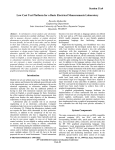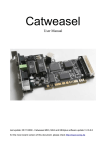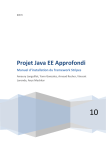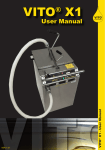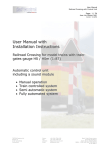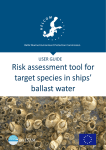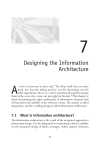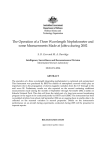Download Bosch_2000 WB-B2B – A WEB
Transcript
Bosch_2000 WB-B2B – A WEB-BASED TOOL FOR INTERNATIONAL PROJECT MANAGEMENT Christian Breu and Norbert Meckl* Patricia Shiroma-Brockmann** Michael Bosch∀ ABSTRACT For the development of the first manned mission to Mars, thousands of industrial contractors, universities, and research institutions will need to work closely together. Important project data, such as project progress, performance, deadlines, costs and cash flows, will need to be transferred between contractors and their subcontractors. The technical implementation of these interfaces will be quite challenging, because the project participants often use different project management software. This makes the automatic integration of data much more difficult. As a result, costly and time-consuming manual integration is usually necessary. In order to alleviate this problem, the European Space Agency (ESA) requires all contractors to use the same software: ECOS (ESA Costing Software). With ECOS, the electronic invitations to tender can be distributed electronically by the contracting agencies. Subcontractors send their proposal bid data electronically to the next higher contractor, who can then integrate these data in their proposal bid automatically. Other software packages have extended this philosophy to include completion of all phases of the entire project. The disadvantage of this method is, that one particular contractor could be forced by each of their different customers to use a special software package for project management. WB-B2B (Web-Based-Business-to-Business) is a software system, which solves the conflict between internal and external integration. This tool integrates all project data over the entire project life cycle across enterprise boundaries and over multiple hardware and software platforms by using the Internet. Both the call for proposals as well as the development of proposal bids on each contractual level can be conducted over a B2B platform. Furthermore, the e-procurement interface makes it possible to connect to already existing virtual B2B market places. In this paper, WB-B2B and its possible application in an international Mars mission will be presented in detail. 1. INTRODUCTION The development and production of interplanetary space-flight systems present challenges, which can hardly be compared to other branches. Especially for manned missions, University of Regensburg University of Applied Sciences Nuernberg ∀ Contact Author: [email protected]; University of Applied Sciences Albstadt Sigmaringen; Anton-Guenther-Str. 51; D-72488 Sigmaringen * ** technically perfect system solutions need to be developed in order to assure safe missions. Even for missions carried out by a single country, an organization which guarantees cooperation between main contractors and subcontractors, government agencies, universities and research institutes is necessary. A project as large and as complex as a manned Mars mission requires a division of labor among highly qualified specialists, departments, enterprises and scientific institutions. In addition to technicians, experts in the natural sciences, computer sciences, medicine, business, law, and in the operation and utilization are also necessary. If the first manned mission to Mars is carried out as an international program, additional management efforts due to the following characteristics are required: Development and finances must be regulated by contracts between the participating countries. Different languages, cultures and legal systems must be taken into account. Therefore, the project information system must guarantee an interdisciplinary integration of different countries, companies, specialists and contractors. (Bosch, 1999) In this paper, the disadvantages of traditional project information systems during the following phases will be discussed: invitation to tender, preparation of proposal bids, project planning and project execution. Next, a prototype for the Web-Based B2B System developed by the authors will be presented. This system uses new, Internet-based technology to solve the problems discussed previously. 2. INVITATION TO TENDER AND TENDER INTEGRATION On multinational projects, the external cooperation between project partners is organized according to contracts between industrial prime contractors, main contractors and subcontractors. The signing of contracts between prime contractors and subcontractors is preceded by a multi-hierarchical proposal phase. During the invitation to tender phase, the goal is to use a competitive environment in order to either find potential contractors who can provide certain systems and services for the lowest possible costs, or to receive the maximum amount of systems and services for a given budget. The geographical return rule is an additional reason for the inclusion of subcontractors within the jurisdiction of the European Space Agency (ESA). Most of the time, the space agency for a given international partner names a prime contractor who is responsible for the completion of a given project. The prime contractor holds a turn key contract and is thus fully responsible for the leadership and management of the entire project, for supervising the subcontractors and for the development, integration and delivery of the system (Korbmacher, 1991). The invitation to tender and proposal integration phase is conducted as follows. First, the space agency issues an invitation to tender to all potential prime contractors. Project requirements, cost and schedule plans are also sent along with this invitation to tender. While putting together their proposal bids, the potential prime contractors decide whether they will outsource portions of the project to subcontractors. If subcontractors are chosen, they also have to make corresponding decisions. Each potential subcontractor puts together a proposal bid and submits this bid to their contractor. The contractor then evaluates these bids and selects the best one. The selected bid must then be integrated into the contractor’s proposal bid. Finally, the contractor’s bid is submitted to their contractor on the next higher hierarchical level. This recursive process continues until the potential prime contractors have submitted their bids to the space agency. The space agency then selects one of the prime contractors. Figure 1 shows a graphical representation of this process. Invitation to Tender (ITT) sent out Space Agency Prime Contractor Subcontractor Level 1 Subcontractor Level 2 Generation of Tender (GT) Selection (SE) and Tender Integration (TI) SE ITT ITT GT SE/TI ITT GT SE/TI ITT GT SE/TI Fig. 1: Invitation to Tender and Tender Integration The external project organization for each of the international partners is specified in the contracts between contractors and subcontractors. As shown in Figure 2, each subcontractor serves in turn as contractor for their subcontractors. Space Agency Customer for Prime Contractor Customer for Subcontractor1 Subcontractor2 Subcontractor3 Customer for ... Customer for Customer for ... Subcontractor 21 Subcontractor 22 Subcontractor 23 Customer for ... Customer for ... Customer for ... Fig. 2: Multi-hierarchical Relationships Between Contractors and Subcontractors The process described above originally required a tremendous amount of time and money, because everything was done on paper. Schedule delays and additional costs were incurred by sending the invitations to tender and the proposal bids by mail. Unjustifiably high costs and error rates were caused by having to manually reenter data from one system into another. In order to combat these problems, during the 1980’s, the European Space Agency (ESA) introduced the ESA Costing Software (ECOS). ECOS makes it possible to process the invitations to tender and the integration of the proposal bids by computer. The goal of this system is to allow contractors to submit proposal bids either on a diskette or via modem. This is especially helpful for space projects where several industrial subcontractors are involved. ESA requires their industrial contractors to use ECOS for certain projects (ESA, ECOS User’s Manual, 1992). Worldwide, ECOS was the first system of this type. During the proposal phase, ECOS helps with the development of the Product Tree (PT) and the Work Breakdown Structure (WBS). Under certain conditions, each subcontractor can extend the PT and WBS from their contractor, simply by adding additional nodes. In this manner, stepwise refinement of the project structure is achieved. The WBS is generated in ECOS together with the Invitation To Tender (ITT). An ITT is an invitation to potential prime contractors to submit a proposal for a given project. Space agencies start the proposal phase by sending ITT’s to potential prime contractors. This process continues recursively down to the lowest level of the project organization. Each subcontractor participating in the proposal can extend the systems structure and the WBS to reflect their contribution. When a contractor decides to outsource work packages to a subcontractor, he is responsible for defining ITT’s for each of the potential subcontractors. Because each contract can be subdivided into a contracted part and an own part, ECOS also requires the definition of an ITT for the part completed by the contractor himself. (ESA, ECOS User’s Manual, 1992) ITT 1 ITT 2 Fig. 3: Definition of ITT ITT 1 is defined for Subcontractor 1; ITT 2 is defined for Subcontractor 2. The contractor is solely responsible for the integration of the entire system; he does not participate in the development of the subsystems. After the ITT’s have been defined, the contractor uses ECOS to generate ITT files. These ITT files are then sent, either on diskette or via modem, to the responsible subcontractors. WBS nodes within the jurisdiction of one subcontractor can not be worked on by the contractor. Once the contractor has defined an ITT as ready for Data Entry, then the system structure and the WBS can not be changed by a subcontractor. The subcontractor is only allowed to enter technical specifications, costs and schedule data for existing nodes. Once a contractor has defined an ITT as ready for ITT-Handling, this implies that it would be possible to include additional subcontractors. Once the ITT’s have been sent to potential subcontractors, then the contractor has completed their handling of the ITT’s. The next process step consists of the integration of the tender bids from the subcontractors (tender integration) within the contractor’s own proposal bid. The contractor’s bid is then, in turn, integrated into the proposal bid at the next higher level. (ESA, ECOS User’s Manual, 1992) The proposal process can only be conducted as described above if all of the participating enterprises utilize ECOS. If a contractor has other customers in addition to ESA, then the contractor would be required to use different proposal systems for each customer. This could lead to an unmanageable number of different systems for each contractor. 3. PROJECT EXECUTION During the project execution phase, many different types of data need to be exchanged between the contractors and subcontractors shown in Figure 2: schedule data, performance data, technical data and financial data. Furthermore, data from each subcontractor has to be aggregated for the contractor on each of the next higher levels, all the way up to the prime contractor. If all contractors for one project are allowed to choose their own project management software, then different data formats and different integration methods lead to incompatible systems. The result is costly manual integration work at the interface between contractor and subcontractor. Special project management systems, which can integrate multiple enterprises and which have adapted ECOS methods for project execution, already exist. The ISPMS prototype, which was developed at the University of Regensburg in the middle of the 1990’s, is an example of such a system. If all project participants are required to use ISPMS, then completely automatic integration of project management data for multiple enterprises can be achieved without any additional manual data entry. During the project-planning phase, the plan data for each subcontractor can be transferred to the contractor on the next hierarchical level. These data can then be integrated into the contractor’s project plan. This continues on each higher hierarchical level, until a complete project plan has been developed on the prime contractor level. Data for the technical and administrative project control (technical performance control, task performance control) can be aggregated and integrated in the same way, for each of the hierarchical levels. During project execution, data about the actual state of the project progress can be compared with the project plan. Furthermore, the original plan can be revised and adjusted to reflect the current project situation. The implementation of the software necessary for this concept is relatively simple and inexpensive. All of the programs necessary for the ISPMS project management system run on a standard PC. ISPMS can be installed for each of the project participants. (Bosch, 1997) 4. PROBLEMS WITH TRADITIONAL SYSTEMS As stated previously, the problems associated with data redundancy and the integration of data between enterprises can be avoided. This can be achieved if all project participants use the same standard, unified project management system for both the proposal phase as well as the project execution phase. On the other hand, though, each contractor is confronted with a problem: each of their customers could theoretically require them to use a different project management system for each project. This could result in an unacceptable number of different project management systems (PMS) on the level of a certain contractor. Figure 4 illustrates this problem graphically. Customer 1 Customer 2 Customer 3 Customer 4 PMS 1 PMS 2 PMS 3 PMS 4 Contractor PMS 1/2/3/4 Fig. 4: Customer Software Requirements from the Perspective of a specific Contractor The challenge is to develop a standard information system that can be used for multiple enterprises, without limiting the software independence of a single contractor. 5. WEB-BASED B2B CONCEPT WB-B2B is an Internet-based project management platform that runs on a Webserver. It is based on a centralized database with a Web interface, which means that data input and output is performed with a Web browser over the Internet. Each user sees his own special views of the database, generated by dynamic, individually generated forms. User authorization is conducted by a unique login password. The proposal phase is conducted in the following manner. First, on each hierarchical level of the project, a contractor enters all of the necessary information into the central database. Potential subcontractors are invited to submit their proposals. This invitation to tender can be transferred over several different electronic media and does not need to contain the project details. The detailed information can be obtained by logging into the specified address on the Internet. Potential subcontractors can log into the system and are identified by a login password specified by the contractor. They then can see the detailed information about the invitation to tender and can submit their proposal bids over the Internet. Once a proposal has been received, then the appropriate contractor is automatically notified either via E-mail or via cellular telephone using the Short Messaging System (SMS). The contractor can immediately view the proposal bid over the Internet with the WB-B2B system. In addition, WB-B2B performs an analysis and suggests a preliminary selection of the proposal bids. Contractors can generate additional project nodes on lower hierarchical levels for multiple subcontractors. The result is a project structure, where each subcontractor is only allowed to view data for their respective subproject. The contractor retains control over both their own data as well as that for the hierarchical level directly beneath them. Once a contractor has all of the project documents (e.g. technical specifications, schedules and planned costs) in digital form, then these data can also be stored in the database. These data can then be viewed at any time by the contracting agency. After a contract has been awarded, data and user rights that are no longer needed can be deleted. During the project execution phase, each participating contractor is assigned a client certificate. Client certificates serve as an additional guarantee of authenticity when used together with a login password. WB-B2B also offers a communication platform. Messages can be posted to project nodes. Electronic documents can be discussed and suggestions for improvements can be made. Comparison of data during the project execution phase occurs on the contractors’ respective internal information systems, using their preferred database and project management software. The necessary data transfer can be conducted using either the Internet-based forms interface already presented or using other agreed upon universal interfaces, such as ASCII files or SQL (Structured Query Language). The results of the data comparison can then be uploaded to the Internet (according to the “push” principle). Alternatively, if the enterprise is willing to allow the WB-B2B system access, can be directly accessed by the WB-B2B system (“pull” principle). Changes in planned schedules, costs or products which may occur at any point in the project structure during the project execution phase are sent to the next higher level contrac- tor, either via E-mail or via SMS. At the same time, these changes are immediately recorded in the database and automatically included in the aggregated data on the next higher level. 6. TECHNICAL IMPLEMENTATION The logic of the application software is embedded in a Java program, which runs on the centralized Web server. This program handles the interface between the database and the Web application. It is responsible for verification of users, database access, data processing, the application logic and the generation of Web content. The system is organized according to the “thin client” principle. This means that the server is responsible for performing all of the program processing. On the client side, all that is necessary are relatively inexpensive PC’s, Macintoshes or UNIX computers with Internet connections and relatively recent browser software (e.g. Internet Explorer, Netscape Communicator, version 3 or higher). As a result, the enterprises usually will not have to buy any additional hardware or software. Requests from client computers are handled by Java Servelets and Java Beans (Sun Microsystems), which translate these requests into database queries. The resulting data are then sent to Java Server Pages (JSP). The JSP convert these data into HTML (Hypertext Markup Language) pages, which can be viewed with the browser software. These HTML pages are then sent to the client computer. By using the programming language Java, the Web server is independent from any platform. This means that the same software can run on a number of different operating systems, for example, Windows NT, LINUX and Solaris. Access to the centralized database is done with the standard database interface, SQL. The advantage of using SQL is that for each project, the best-suited database management system can be selected. For example, Oracle could be used for larger projects and MySQL could be used for smaller projects. Javascript is used on the client side only for the navigation of web sites, error messages or for input validation checks. Input validation checks ensure that the user is informed of input errors before the data is even sent to the server. As an alternative to simply displaying the data in a browser, WB-B2B also offers additional data transfer modes. XML (eXtended Markup Language) is becoming increasingly important as a meta-data definition language. XML is a universal, platform-independent data format. WB-B2B offers the option of creating and sending project data in XML format. WB-B2B’s WAP service, used to send especially time-critical project data to a cellular phone, is based on a variant of XML, called WML (Wireless Markup Language). In the near future, the transfer of voice-based Web content based on Motorola and IBM’s VoiceXML standard is also planned. 7. SECURITY ISSUES WB-B2B fulfills the current security standards for E-business applications. Once a user has logged into the system, the session is automatically closed if the user hasn’t sent any requests for 10 minutes. After each session, the user’s personal data are stored in order to generate the specific Web content he is authorized to view. During each session, encoded, a temporary “Cookie” is stored, which is then deleted when the session is closed. Hostile, external accesses to the database are prevented by a firewall. Thus, it is not possible for unauthorized persons to read, change or delete data. A “Man in the middle Attack” is, when an unauthorized person attempts to listen in on or to falsify data transfers. In order to prevent this from happening, a secure Internet connection will be established using SSL (Secure Sockets Layer) encryption. SSL technology takes a message and runs it through a set of steps that "scrambles" the message. This is done so that the message cannot be read while it is being transferred. This "scrambling" is called encryption. When the message is received by the intended recipient, SSL unscrambles the message, checks that it came from the correct sender (authentication) and then verifies that it has not been tampered with. SSL uses digital certificates (or just certificates) to bundle important information together to identify a server or a user. This identification comes in the form of things like the organization name, the organization that issued the certificate, the organization's email address, country, and of course their public key (the part that "scrambles" a message). (www.ssl.com, 2000) BIBLIOGRAPHY Bosch, Michael, Commercialization of Management Know-How Generated by the ISSProgram, in: International Space Station: The Next Space Marketplace (Space Studies Series Vol. 4), Kluwer Academic Publishers, Dordrecht, 1999. Bosch, Michael, Management internationaler Raumfahrtprojekte, Gabler Verlag, Deutscher Universitätsverlag, Wiesbaden, 1997. European Space Agency, ECOS User’s Manual, DRAFT VERSION, PSS-06-101, Issue 2, Cost Analysis Division, ESTEC, ESA, Noordwijk, 1992. Korbmacher, Eva-Maria, Organisationsstrukturelle Problemfelder im überbetrieblichen Projektmanagement, Steuer- und Wirtschaftsverlag, Hamburg, 1991. Secure Sockets Layer, Homepage, www.ssl.com, 2000.









